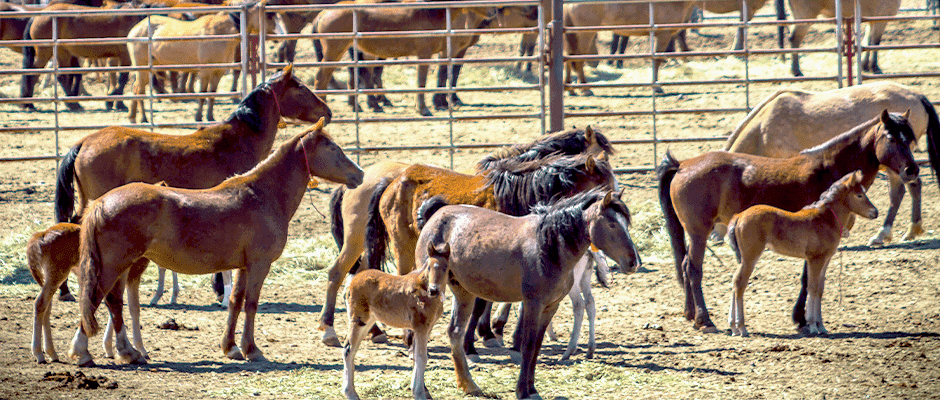Share this article
BLM outlines wild horse and burro management options
The Bureau of Land Management has provided Congress with a report detailing four options to deal with growing populations of wild horses and burros on BLM lands. Congress demanded a new horse and burro management plan last month, including a mandate in the omnibus appropriations bill after the BLM failed to produce a plan that was originally requested in the fiscal year 2017 spending bill.
Legally-defined “wild” horses and burro herds can degrade western rangelands as they deplete water sources, overgraze vegetation and displace native wildlife.
The national Appropriate Management Level (AML), or the number of horses and burros the rangeland can ecologically support, is 26,715 animals. According to the report, the BLM estimated there were nearly 83,000 wild horses and burros on the range at the end of 2017. The expanding overpopulation of horses and burros has frustrated the agency and Congress for years.
The BLM conducts gathers to remove excess horses and burros and houses them off-range to be adopted or sold with limitations. Congress currently restricts the euthanasia and sale of the animals. If an animal is not sold or adopted, it remains under BLM care for its lifetime. The BLM spent nearly 60 percent of its FY2017 budget caring for more than 46,000 horses and burros in holding, costing taxpayers nearly $50 million.
Each of the four options outlined in the report provide plans for on- and off-range management to reach the national AML. The “factors of success” for each plan vary but include potential changes to funding levels, legislation and National Environmental Policy Act requirements. The BLM does not identify a preferred option.
Option 1:
The first option aims to achieve the national AML in eight years by continuing gathers, using fertility control and transferring off-range horses and burros into private care. Animals not transferred would be sold without limitation or euthanized, as authorized by the Wild Free-Roaming Horse and Burro Act of 1971. Selling without limitation or euthanasia, however, have been prohibited since 2010 by language in appropriations bills, so implementing this plan requires that Congress remove these prohibitions.
Costs for Option 1 are estimated to be $115 million every year between FY2019 to FY2021 as the BLM administers the program. Costs are expected to decrease after FY2021 as the number of horses and burros in off-range holding decreases.
Option 2
Option 2 focuses on achieving AML in 10 years by using contraceptive fertility control treatments, such as Porcine Zona Pellucida (PZP) and continued on-range gathers. Under this option, the number of horses and burros in holding facilities will increase, so the BLM will need to secure more low-cost open pasture housing for excess animals.
The cost for Option 2 will vary depending on partner agreements and additional pasture prices, though the BLM estimates costs at $116 million in FY 2019 and increasing to $248 million in FY 2027.
Option 3:
This option plans to achieve AML in six years by conducting intensive gathers and using permanent sterilization procedures in key areas to reduce on-range populations and population growth. This option also allows time for the development of an effective, easy to administer, and long-term fertility control treatment which would reduce the need for gathers. Available fertility control treatments, including PZP, must be administered annually to be effective.
This option would also establish an adoption incentive of $1,000 per animal to help defray the costs of owning a horse or burro.
The BLM estimates costs for this option will be $133 million in FY 2019 and will increase to $147 million in FY 2023. In the event an improved fertility control method is developed, costs are expected to decrease.
Option 4:
This option involves the use of intensive gathers and permanent sterilization to reach AML in 12 years. Gathers and sterilization procedures would be used in the first six years, allowing time research to develop a long-term fertility control treatment reducing the need for permanent sterilization. Most of the sterilized horses and burros would be returned to the range to minimize the growth in off-range holding costs. The option also establishes a $1,000 adoption incentive program.
The BLM estimates costs for this option would increase from $135 million in FY 2018 to $143 million in FY 2023. Costs are expected to decrease as horses and burros in off-range facilities reach natural lifespan limits and if a more efficient fertility control treatment is developed.
All four options call on Congress to categorically exclude certain wild horse and burro management activities from requiring an environmental assessment to comply with the National Environmental Policy Act. Currently, this analysis is required for every planned wild horse gather, administering of fertility control and management activities. The BLM says that with categorical exclusions the “completion of NEPA review would be much more efficient and timely.”
TWS, alongside the National Horse and Rangeland Management Coalition, has led efforts in recent years to improve the management of wild horses and burros to ensure healthy rangelands and wildlife. TWS and the coalition participated in the National Wild Horse and Burro Summit last August, and regularly provide written testimony to the National Wild Horse and Burro Advisory Board encouraging the use of all available management options to reduce on-range horse and burro populations. The advisory board’s last meeting was in October 2017, and the board’s March 2018 meeting was postponed.
Read TWS’ position statement on Feral Horses and Burros in North America.
Header Image: The BLM has provided multiple management options to Congress to address wild horse and burro populations on western rangelands. ©BLM








